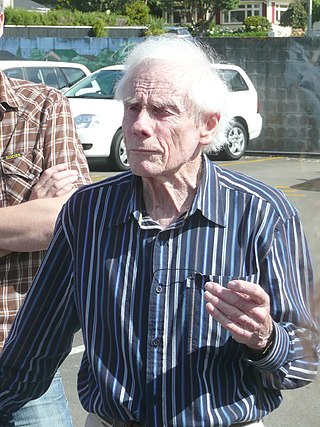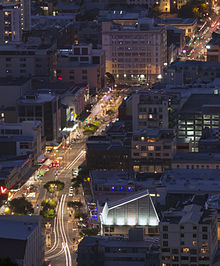
Courtenay Place is the main street of the Courtenay Quarter in the Wellington inner-city district of Te Aro.

Stanley William Toomath was a New Zealand architect who practised mainly in Wellington. He was a founding member of the Architectural Group in Auckland in 1946, a life member of the Wellington Architectural Centre and a Fellow of the New Zealand Institute of Architects. Both the founding of the Group and the Architectural Centre were important factors in New Zealand's modernist architectural history.
James Albert Beard was a New Zealand architect, town planner, and landscape architect.

Don Charles Selwyn was a Māori actor and filmmaker from New Zealand. He was a founding member of the New Zealand Māori Theatre Trust and directed the 2002 film Te tangata whai rawa o Weneti , the first Māori language feature film with English subtitles.

Downstage Theatre was a professional theatre company in Wellington, New Zealand, that ran from 1964 to 2013. For many years it occupied the purpose-built Hannah Playhouse building. Former directors include Sunny Amey, Mervyn Thompson, and Colin McColl.
Philippa Campbell is a New Zealand film and television producer and the Literary Manager at the Auckland Theatre Company.
Brian Sergent is an actor born and based in Wellington, New Zealand.
Martyn Sanderson was a New Zealand actor, director, producer, writer and poet.
Joseph Musaphia is a New Zealand writer and actor who was born in London.

Sarah Delahunty is a New Zealand writer and director who was born in Wellington. An award-winning playwright, Delahunty has written over 30 plays, often focussing on works for youth.
Richard Meckiff Campion was a New Zealand actor, theatre director, and producer.
Taki Rua is a theatre organisation based in Wellington, Aotearoa / New Zealand that has produced many contemporary Māori theatre productions. Taki Rua has been going since 1983 and has had several name changes over that time including The New Depot, Depot Theatre and Taki Rua / The Depot. The full current name is Taki Rua Productions. Since inception the mission of Taki Rua has been to showcase work from Aotearoa. Because of this and the longevity of Taki Rua many significant New Zealand actors, directors, writers, designers and producers have part of the history including Riwia Brown, Nathaniel Lees, Rachel House and Taika Waititi.
Raymond Stanley Boyce was a British-New Zealand stage designer, costume designer and puppeteer and puppet designer. Boyce was part of the start professional theatre movement in New Zealand influencing the artistic landscape with his design knowledge. Boyce designed hundreds of theatre shows and was named an Arts Foundation of New Zealand Icon in 2007.

Circa Theatre is a professional theatre company in Wellington, New Zealand, that was established in 1976. They present a number of plays each year in their two auditoriums, and have a unique partnership and funding model with incoming shows underpinned with a cooperative principle.
Sunny Amey is a theatre director and educator born in New Zealand. She worked at the National Theatre of England during its formative years alongside Laurence Olivier, as artistic director of Downstage Theatre in the 1970s and the director of New Zealand's national drama school Toi Whakaari in the late 1980s.
Diane Prince is a painter, weaver, installation art practitioner and set designer and affiliates to the Maori iwi Ngā Puhi and Ngāti Whātua from the north of New Zealand.

Michael Haigh was a New Zealand actor, narrator and teacher.
Jenny Wake is a New Zealand actor and theatre director. In 1991 she founded Calico Young People's Theatre.

Edith Campion was a New Zealand actor, writer, and a co-founder of the New Zealand Players theatre company.
Sheilah Maureen Winn was a New Zealand arts patron and philanthropist. Having received a large inheritance, she used her money to support her love of the arts and particularly the theatre. Notably, she was the founding donor of the Hannah Playhouse in 1966, co-founder of the Katherine Mansfield Menton Fellowship in 1970, and principal sponsor of the National SGCNZ Sheilah Winn Festivals of Shakespeare in Schools in 1992.










